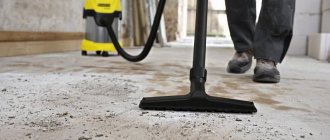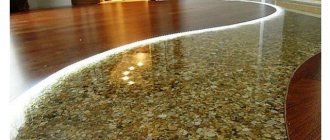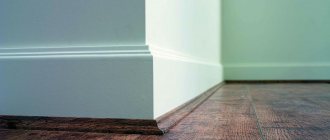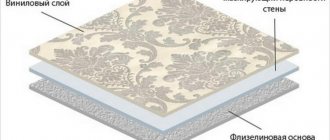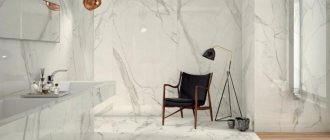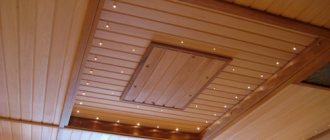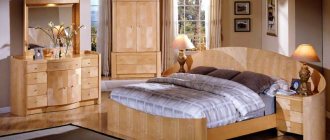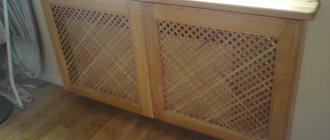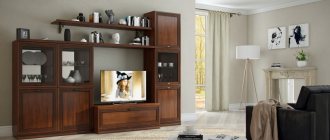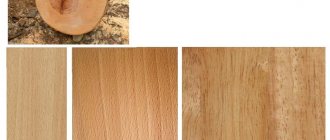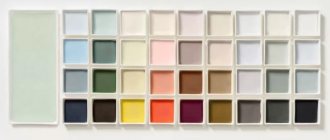A variety of interior design solutions for cork flooring
Owners of private houses are increasingly choosing cork flooring because it is not only convenient to use, but also looks aesthetically pleasing and prestigious. It is very comfortable to walk on such a surface; you can even lie on it and not freeze, and this is very important for rooms in which children will sleep and play.
PHOTO: centrlaminat.ru The popularity of balsa wood flooring is growing; it is used not only in country houses, but also in city apartments
PHOTO: parquet-master.rf Cork flooring looks aesthetically pleasing and environmentally friendly
PHOTO: premium-laminate.ru If you choose the right shade, you can decorate any interior
PHOTO: tonysflooring.ca When choosing wood and the type of cork floor, you should take into account the general direction of style in the interior of the apartment
What cork floors look like in the interior: photo
The use of this coating in the interior can be varied. In the photo, cork floors look prestigious and original, especially in the living room, bedroom and study. Use in a children's room is allowed, but subject to careful handling. The coating can be made in natural colors (natural) or painted in any shade of the palette.
The most common natural colors:
- yellow;
- ocher;
- light brown;
- red-brown;
- mustard, etc.
Note! When choosing the color of the future coating, you must take into account the design and colors of the furniture.
Is it possible to use cork floors in the bathroom and kitchen?
In any premises where the microclimate involves a constant change in temperature, the cork will deteriorate and crumble. Such rooms include not only the kitchen, but also the bathroom, which is also characterized by a high level of humidity. Temperature changes provoke the appearance of cracks in the coating. As a result, water begins to seep into the cork, causing the coating to peel off. It is also not recommended to use cork on the balcony and in the hallway.
Problem areas are usually hidden from view:
- under the bath;
- behind the baseboard;
- under the sink;
- under the washing machine;
- behind floor furniture.
It is in these zones that water vapor settles and condenses, destroying the coating. As an alternative, a quality waterproof varnish can be used to protect cork floors in your kitchen or bathroom. However, it does not prevent the appearance of mucus blisters. Under the influence of humidity, they appear under the top layer of coating and spoil its appearance. In addition, cork does not have antiseptic properties, so a microbiological environment can form under it.
For the kitchen you should choose a cork floor with an additional protective layer
Experts do not recommend using cork in the bathroom. In terms of microclimate, the kitchen has more gentle conditions, although even there the floor will be subjected to serious tests - constant pollution, spilled liquids (juices, coffee, tea), etc.
How to install cork flooring in slab form
Cork reacts sensitively to moisture levels, shrinking and expanding depending on room conditions. Therefore, before starting work, it is advisable to keep the package of material for several days in the room where it will be installed. During this time, the humidity level stabilizes. As a substrate for the coating, you can use a technical roll cork. The optimal thickness of this material is 2-3 mm. You should move 1.5 cm away from the wall. The technical plug is laid on a waterproof film on top of the concrete screed.
Technical roll cork - the best option for flooring underlay
Installation of the first row begins from the wall, which is located opposite the entrance door, with a 5 mm indentation. If the material needs cutting, the cut is made on the side where the ridge is located. The groove cannot be touched. To cut the cork, it is advisable to use a circular saw or an electric jigsaw. It is better to refuse hand tools, otherwise the cork will crumble. The second row is set with an offset of half the tile. To adjust the elements, use a wedge (cork) and a rubber hammer.
Important! Be sure to leave a space of 1-2 cm from the wall. Like any natural material, cork undergoes deformation changes, so you need to leave a small space for expansion.
Wooden skirting boards will help hide the joint area near the walls.
After this, the coating is treated with several layers of varnish. The composition can be matte or glossy. The joint area near the wall is masked using wooden baseboards.
All the pros and cons of cork floor tiles
Cork covering not only looks beautiful, but is also very practical and even useful.
Pros of installing cork flooring in your apartment:
- long operation;
- environmentally friendly material, safety;
- There are no dangerous or toxic emissions during use;
- light and soft material;
- good sound insulation, air exchange;
- Cork is a good antistatic agent, so dust practically does not accumulate.
Before choosing this material, you should also familiarize yourself with its disadvantages:
- the thin coating is pressed through by heavy furniture and even stiletto heels. Thick coating up to 1.2 cm can support the weight of the bathtub;
- latex mats and rubber shoes leave marks that cannot be erased;
- high cost of cork;
- flammability. The cork itself is not flammable, but the glue and varnish with which it is processed are flammable;
- moisture resistance is low, it is recommended to additionally use a sealant, otherwise the material will swell.
PHOTO: ural.org Cork floors retain heat well
Advantages and disadvantages
➤ Pros of cork flooring:
- Waterproof and moisture resistant. Thanks to the membrane structure of cork, the flooring does not absorb water during direct contact for a long time, and also remains stable under changes in temperature and humidity.
- Natural warmth for comfortable walking. Cork flooring has low thermal conductivity: thanks to this, the floor covering retains heat , no additional heating is required.
- Eco-friendly material. There are no harmful components in the structure, only natural cork.
- Removing shock loads. Thanks to the elasticity of the cork, walking on the floor is a pleasure and the musculoskeletal system is not subject to stress.
- Elasticity. After removing the load, the cork is restored: not a trace will remain of the furniture legs when rearranged!
- Soft surface. Cork flooring is moderately soft : your favorite cup will not break, and household injuries from falling are excluded!
- Application in unheated rooms. On a balcony or in a country house, cork flooring is frost-resistant and can withstand prolonged exposure to negative temperatures without consequences.
- Soundproofing. Floor cork completely eliminates the noise from footsteps , and also provides additional sound insulation for the floor covering: the use of underlays is unnecessary .
➤ Conditional disadvantages of floor plugs:
- Laying. A cork floor requires a particularly carefully prepared base . To ensure that the flooring lasts a long time, installation must be carried out by professional installers.
- Price. To the price of a floor plug, you must add the cost of glue and varnish, as well as laying and preparing the base.
- Incorrect choice. Cork floor coverings are of the locking and adhesive type: when choosing, it is important to take into account the characteristics of the room and the expected operating conditions .
Where is cork flooring used?
Cork flooring is unique and can be used in almost any room, especially in a living room.
To extend the service life, it is recommended to choose a product with certain characteristics and a high strength class.
PHOTO: your-photographer-daniil.rf
PHOTO: centro-pol.ru
How is oak bark turned into flooring?
This is done in different ways. Or rather, the technology used is always similar, but there are differences in the quality of raw materials and costs. By the way, from the removed cork they make not only coverings for floors, but also for walls and ceilings too. So, the following options are possible:
- Solid veneer obtained from cork wood. This is the most expensive coverage. When using it in order to form one collection, selection is made according to the color and texture of individual floorboards.
- Agglomerate. This is pressure-pressed cork chips. It is sintered under high heat to produce a solid material. This is the cheapest option, since any, even the smallest fragments of cork are used.
- Combination of agglomerate + veneer. A price-compromise solution. In this material there are parts of veneer mixed with small pieces of cork.
A little more detail needs to be said about the agglomerate. Both the wear resistance and other mechanical properties of the two types of agglomerate from large and small crumbs do not differ. Externally, they are also poorly distinguishable. Since plasticizers are used to obtain such a material, it, of course, is significantly inferior to veneer in environmental matters.
Structure and performance characteristics of different types of cork floors
Manufacturers offer several options for cork coverings with different characteristics:
- solid veneer is an expensive but high-quality coating. The composition includes whole pieces of tree bark. This material is most often used for finishing floors, niches and ceilings;
- glomerate is an affordable and practical material. In production, crushed bark is used, which is glued and joined into sheets;
- combined cork - this type of coating is produced under very high pressure. The veneer is glued with glomerate and a solid, reliable sheet is obtained. It is aesthetically pleasing and unusual looking and can be used for decorative purposes.
Before making a purchasing decision, it is worth considering all types of cork flooring.
Structure and nuances of installing a floor adhesive plug
Adhesive cork boards have several layers and bend well. The average thickness of one sheet is from 4 to 6 millimeters. As a rule, the first layer is pressed chips, and the second is veneer.
PHOTO: undhaus.ru The adhesive cork floor has a multi-layer structure
In order to improve performance, the manufacturer applies an additional protective coating. In addition, upon request, photo printing can be applied to the floor. This will add zest to the interior.
PHOTO: static-eu.insales.ru Cork floor with photo printing
Features of installing adhesive floors
Before you start laying the floor, you need to prepare the room well and make sure that there are no significant differences in height at the junction of the panels. This may cause the cork to crack. For installation, special glue is used.
If the work is carried out by an experienced and qualified craftsman, he can lay out different patterns and decorative images from cork. After the coating has been laid, several additional layers of protective varnish are applied.
PHOTO: dekormyhome.ru If the look of an ordinary cork seems boring, you can use a photo printing service and create such a marine style
Structure and functional features of interlocking cork flooring
To ensure that the coating holds tightly, all individual panels are connected to each other with locks located at the joints. These are very durable and reliable elements made from fiberboard. Laying and installation is carried out in the same way as laying laminate flooring.
Manufacturers of castle floors use fine chips, and also additionally cover the material with protective layers of varnish and apply a decorative image or paint it.
It is important to take into account that such a floor is very sensitive to temperature conditions, and when sudden changes and temperature fluctuations occur from cold to warm or vice versa, the locking joints split.
You should know this! When purchasing materials for repairs, you need to pay attention to the condition of the locking joints. If they initially do not have defects, then their service life increases.
PHOTO: pol-comfort.ru The castle floor has a complex structure
Floors with such compounds are intended for installation in private houses and apartments, and are absolutely not suitable for public organizations and enterprises with a large flow of visitors. Also, such a floor is not installed in the hallway, kitchen or bathroom.
PHOTO: happymodern.ru To lay the panels you do not need to have special skills; even a simple all-round builder can cope with this task
What is it - technical cork coating
To make technical coating, the manufacturer uses the remaining material. It is chosen to prepare the base and create a substrate. Granules are suitable for eliminating existing floor defects and preparing the surface.
Technical covering made of cork is also used as a heat and sound insulating material.
This coating comes in several forms:
- roll;
- granules;
- plates.
PHOTO: diy.obi.ru Technical cork covering in the form of rolls is used when laying the floor as a substrate
Composition of cork coating
As a base for a cork floor laid with glue, pressed bark artificially saturated with air is used. Thanks to this processing technology, the material’s heat-insulating and sound-absorbing qualities are improved. Next, the products are given the necessary strength indicators. To do this, fine wood dust is added to the base composition of the raw material, which binds to the cork particles thanks to special resins.
The top finishing layer of the floor covering can be made from the same type of raw material or polyvinyl chloride. The service life, as well as the scope of application of the products, will depend on the material used to make the top protective layer. To protect the material from premature wear, as well as to impart a certain design to the decorative coating, veneer is used. This element can be successfully combined with other products:
- A thin layer of veneer within 0.5 millimeters is glued to the base of the adhesive cork covering.
- Veneer, coated with a protective layer of varnish, is successfully used for laying floors in various residential areas, including the living room and bedroom.
- Veneer covered with durable vinyl film protects the decorative coating from various mechanical influences, including scratches. This layer prevents moisture from entering the structure of the material. Thanks to these characteristics, the manufacturer provides a guarantee for the operation of its product for 10 years.
- Veneer of natural origin from valuable types of wood is expensive. To protect from external influences, the material is covered with vinyl film.
Important! Thanks to the introduction of modern advanced technologies, users can purchase cork coverings of any design that imitate the texture of wood, the surface of stone, sand or grass. Everyone can choose a coating to suit the individual interior of the room.
Classes of cork by intensity of use and recommendations for use
Depending on how quickly the coating wears off, manufacturers have assigned a certain class to each type of cork floor:
| Class | Purpose |
| 21 | Bedrooms in houses and apartments, offices in a private house. |
| 22 | Living room and library in the house. |
| 23 | Kitchen and corridors. |
| 31 | Suitable for offices with few visitors. |
| 32 | For offices with an average flow of visitors. |
| 41 | Suitable for industrial premises and can withstand the weight of light commercial vehicles. |
PHOTO: dekoriko.ru Cork flooring of 21 thickness classes is suitable for the bedroom
Standard panel sizes
When choosing a coating, you should focus on the standard sizes generally accepted in production - one block of adhesive flooring, as a rule, has a rectangular shape and dimensions 60x30 cm or 45x15 cm.
A square shape is also possible with dimensions: 30×30 cm, 40×40 cm, 45×45 cm. The maximum panel size in length is 120 cm, and in width – 18 or more.
You should also take into account the dimensions of the locking joints - 18.5x90 cm. The thickness of the material can vary from 10.5 to 12 mm.
PHOTO: akvakraska.ru In modern production, several standard sizes are taken as a basis, so you can choose a suitable coating in shape and thickness
Kinds
There are two main types of cork floors in the modern building materials market:
Castle
Lock (floating) cork floor
Lock cork floor, it is also called “floating” or cork laminate. This type of cork floor has a multilayer structure, usually consisting of a base MDF or HDF panel, on top of which there is a layer of pressed cork 2-4 mm thick (it is on this that the design is imprinted), as well as external protection - elastic varnish, parquet oil or dense polyurethane film. Such panels may have another layer of pressed cork underneath, which acts as a substrate.
An example of the structure of an interlocking cork floor (1 - using natural veneer, 2 - using photo printing)
The size range is extensive; on sale you can often see panels of 30×90 cm, 18.5×90 and 20×120 cm. The products are connected to each other using locks. The installation method is similar to laying conventional laminate. The thickness of interlocking cork flooring ranges from 7.5 to 13.5 mm.
It is also worth noting that instead of an HDF slab, a hydraulic slab can be used, which consists of PVC and quartz. This cork floor is more resistant to moisture.
Adhesive
Adhesive cork flooring
The product is a layer of pressed cork, coated on the outside with a layer of varnish. Compared to a “floating” cork floor, this product is more resistant to moisture and temperature changes, so it can be used in the bathroom, kitchen, and also in country houses that are not heated constantly. The thickness of the adhesive cork floor is 4-6 mm.
Read on the topic: Choosing moisture-resistant and waterproof laminate - general information, types and differences
An example of the structure of an adhesive cork floor (1 - using natural veneer, 2 - using photo printing)
The disadvantages of this coating include the complexity of installation and ideal preparation of the base, which is best left to professionals.
Technical traffic jam
Technical cork (agglomerate) is used for sound and thermal insulation. It is also worth mentioning the so-called technical cork or agglomerate. This material is obtained by baking cork chips left over from the production of basic materials. The product is completely natural, as no additional binders are used. Cork agglomerate is used for insulation and soundproofing of floors and walls. The panels are fixed with special glue. Common sizes are 30x30, 45x15, 45x45, 60x30, 60x60 and 60x90 cm.
Variety of colors and designs for cork floors
Using cork boards, you can make ordinary renovations in a residential apartment, or implement unusual design solutions. The main advantage of the material is that it can fit into almost any interior or style solution, while the expenses of the owner of the apartment or house are 100% justified.
Depending on the design project chosen, you can choose the most suitable shades of cork:
- for large living rooms and bedrooms, natural wood and shades of oak, birch, cherry or pine are recommended;
- Warm, yellowish and brown shades are well suited for kitchens;
- facades are laid out with white coating;
- in an apartment with an exotic interior, you can use American walnut and rosewood colored corks;
- for apartments in a modern style, for example, a loft, a coating that imitates pebbles or sea sand will look good.
PHOTO: i.pinimg.com
PHOTO: seal-parket.ru
PHOTO: changepol.rf
PHOTO: asparket.ru
What is the material made from?
Naturally, there is no doubt that the cork flooring is made from natural cork. However, there are several options for the execution of such materials and it is worth considering everything in more detail. The manufacturing process looks like this:
- The bark removed from the tree is dried and then crushed into fine crumbs.
- The crumbs are mixed with resin and wood dust, after which they are pressed into layers of different thicknesses.
- The layers are cut into pieces of the required size and, if necessary, an additional decorative layer of natural veneer or vinyl film is applied to them.
Such products can be used for installation in different rooms and at the same time, there are no contraindications for the use of such finishing in wet rooms, children's rooms or medical institutions. At the same time, cork flooring naturally has some pros and cons, which will be discussed below.
The best manufacturers of cork flooring
The first thing you should pay attention to is the choice of manufacturer. The quality and durability of the coating can only be guaranteed by trusted manufacturers who have been working for several years.
The Russian market offers products from several manufacturers whose reputation is the best of all:
- Wicanders , head office in Portugal. Cork from the Iberian Peninsula is used, and only the latest and improved technologies are used in the production of the coating;
- Corcart is also a Portuguese company that produces coatings with an unusual, unique design;
- CorcStyle is a manufacturer from Switzerland, recognized throughout the world. During the production process, boards undergo strict quality control, collections are constantly updated, models of interesting designs and with good protection from moisture are presented;
- “Maestro” is the main supplier of flooring in Russia under the “PolImPex” brand, offering high quality products;
- Egger is a German company. The quality has been appreciated all over the world. The manufacturer uses technologies for applying the image in such a way that it does not wear out or fade for a long time.
PHOTO: eparket.com Cork floor with photo printing on a protective layer
Types of cork-based coatings
All cork materials can be divided into three types, listed below:
Technical traffic jam
It is produced in the form of either plates, rolls, or granules. Most often, technical cork is used as a substrate for laminate (if it is sheets and rolls) or as insulation and soundproofing material poured into the voids of floors and walls (if it is granules).
Cork-based adhesive tile coverings
The size of such plates in centimeters can be: 30×30, 45×15, 60×30, 45×45. You can lay out multi-colored patterns or designs from them. With their help, you can make a cork floor in a bathroom or other wet room.
Floating cork flooring, often called cork parquet
In this case, MDF fiberboard is used as the base of such a building material, to which cork is glued. This coating comes to the market in the form of plates with a size in centimeters: 90 × 18.5. They are assembled in the same way as interlocking laminate. Such a floor cannot be filled with water, because MDF may swell after absorbing moisture.
What type of cork flooring should I buy for my home?
The main question that worries consumers is which coating is best to choose, interlocking or adhesive. In order to make the right choice, you should study the characteristics, as well as all the pros and cons of both types of coatings. And if it’s still difficult to make a decision, then you can also study photographic examples to understand what this or that material looks like.
| Characteristic | Adhesive cork floor | Castle cork floor |
| Humidity | It tolerates moisture well and can even withstand a small flood. | Requires sealant treatment. Seams swell quickly when exposed to water. |
| Base requirement | The floor must be level. | Minor defects are acceptable. |
| Installation | Layout is carried out only by a professional. | You can assemble it yourself. |
| Installation speed | Apply adhesive to the boards and wait until dry. The floor is laid and covered with protective varnish. | In a small room you can lay out the floor in one day. |
| Maintainability | It is possible to repair the damaged part. | It is necessary to dismantle the entire section up to the wall. |
Adhesive coatings are recommended for rooms with high humidity, as well as places where people often walk - corridors, bathrooms, kitchens. For the bedroom and living room, a castle floor is best suited.
PHOTO: bezremont.ru An ideal option for a bathroom is an adhesive cork floor
Choosing cork floors: owner reviews, pros and cons
When choosing a finish for floors, you should pay attention to the quality of the cork agglomerate. Some manufacturers, in order to reduce production costs, add cheap impurities, such as shavings, to this layer. As a result, the material becomes tough and wears out faster. For this reason, you should give preference to clean products, even if it is compressed cork and its cost will be high.
Adhesive floors have their disadvantages. Even products from quality manufacturers may have minor defects. Most often, there are dimensional errors, which is why the planks have different sizes. As a rule, they are small and amount to 1 mm in length or width. This indicator is considered normal, since due to the elasticity of the material, this deficiency is compensated for during installation: the panels are compressed and the joints are tight. Sometimes you come across planks with different thicknesses. This defect brings much more problems.
Example of using cork with a printed design
Helpful advice! If the batch contains planks with different thicknesses, the material will have to be re-sorted. It is better to place thin elements in places where the transition will not be so noticeable. Thick ones can be corrected by removing excess thickness around the edges using sandpaper.
Since cork is a natural material, defects such as depressions, unsightly color transitions, and manufacturing defects (detamination of veneer or its partial absence) are often found on the surface. Before proceeding with installation, you should carefully inspect the material, glue the peeled areas, and place the defective strips where they will not be so noticeable. Castle floors are more advantageous in this regard, because the protective coating hides all imperfections.
There are practically no defects on the surface of floating floors
Considerable importance is given to consumer reviews when choosing cork flooring. The opinion of buyers who have already tried this type of finishing can be informative and decisive.
Strengths and weaknesses of cork floors: customer reviews
Cork cladding is not as popular as other types of finishes that are already well known to buyers. Those consumers who nevertheless took the risk of purchasing this material share reviews about cork laminate on forums.
“We initially considered laminate flooring but found it too noisy and slippery. We have a dog living in our apartment. I don’t want to listen to the constant clicking of claws. We couldn't afford parquet. Therefore, we decided to take a closer look at cork covering. The material, of course, was more expensive than laminate, but its high price was outweighed by numerous advantages. The coating turned out to be soft and quiet, and most importantly, warm. They installed the cork on the floor themselves, without calling a professional to the house. I was captivated by the naturalness and environmental friendliness of this material. I don’t regret my purchase at all and recommend it to everyone. You simply cannot find a more comfortable finish.”
Svetlana Ezhova, Moscow
“I am of two minds about cork floors. The material really has many useful properties. This is beauty, naturalness, and the ability to retain heat. On the other hand, it cannot be called practical. Water causes cork to swell, so the seams between the slabs may swell. I also cannot recommend this coating to those who have children in the house, because the surface of the cork is very sensitive to damage. The material requires careful handling. If you're willing to take proper care of it, cork won't disappoint."
Maria Korotaeva, St. Petersburg
To protect the natural coating from external mechanical influence, the floor should be treated with varnish, sealant or wax impregnation
The nuances of installing cork coverings
Once the floor has been selected, laying it on metal or concrete begins.
Features of the technique for installing a cork floor with a locking connection: video of a step-by-step process
Laying occurs using the same technology as laying out laminate flooring. The work order is as follows:
- The film is placed.
- The first row is laid out. It is necessary to make a gap of 1 cm between the wall and the floor.
- The second row is laid out. It is necessary to achieve an offset of half the length of one panel.
Master class on video posting:
Difficulties in laying adhesive cork coverings
The floor covering is carried out by a master with certain skill and experience. It is important that the base is well prepared and sanded. It is best to cover it with glue, and only then lay out the cork.
Features of installing an adhesive floor in the video:
Features of laying cork flooring
Let's look at a few popular questions that arise when laying cork floors:
“Does it make sense to install a “warm floor” system under a cork flooring?”
— Cork has very poor thermal conductivity, and in turn reflects the heat of your feet, so the floor itself is quite warm, and it makes no sense to install a “warm floor” system.
“Do I need to install underlayment under interlocking cork flooring?”
— Interlocking cork flooring (cork laminate) has its own backing, so if you are confident that the base is even, you don’t need to lay the backing. Manufacturers, in turn, recommend laying a cork underlay with a thickness of no more than 2-3 mm in order to increase the sound insulation and shock-absorbing qualities of the floor. But in any case, whether you use a substrate or not, you need to lay a waterproofing film that protects the cork laminate from condensation.
Cork backing has excellent sound insulation properties
Installation technique for cork flooring with locking joints
Even a non-professional can install interlocking cork floors. Laying the interlocking covering is similar to laying the usual laminate flooring. The panels are connected by means of a locking joint; technological gaps between the wall and the cork floor are also maintained at 10 mm. The second row of covering is laid “in a running start”. That is, so that there is a distance between the joints of panels in adjacent rows.
Video on laying interlocking cork flooring:
Laying adhesive cork flooring
If the cork is fixed with glue, during installation there should be a favorable and stable microclimate in the room - a temperature of 20 degrees and a humidity of no higher than 75 percent.
It is advisable to prefer a composition based on an organic solvent over water-based glue, which, although toxic, is not afraid of getting wet and instantly adheres to surfaces.
The base under the adhesive panels must be leveled to the bitter end; height differences, even insignificant by the standards of other materials, cannot be tolerated by an adhesive cork floor.
The glue must be applied both to the surface of the panel itself and to the base of the floor. The glue can be applied to the floor surface using a spatula, and to the panel using a roller, so as not to damage the product.
After application, you must wait about 20 minutes and only then proceed with styling.
Video on laying adhesive cork flooring:
Adhesive cork flooring is often sold not with a full varnish coating, but with a pre-varnish. Therefore, after installation, the floor must be covered with several layers of varnish. The interlocking cork floor does not provide for such a procedure.
On a note:
When exposed to direct sunlight, cork becomes vulnerable to fading. In connection with this feature, in the “kingdom of ultraviolet” it is more practical to lay a light coating, while dark shades are better selected for rooms poorly lit by sunlight.
The best type of varnish in terms of quality is polyurethane, with acrylic or an admixture of solid additives: it is easy to apply, dries quickly enough and significantly increases the wear resistance of the coating, but from the point of view of harmlessness, water-dispersed varnish wins.
Apply the varnish with a roller to a previously dust-free floor. It will be possible to move around the room (by the way, cork absolutely does not tolerate rubber shoes) and arrange furniture only after four days.
It is recommended to check the drying time of the varnish on the packaging for each individual manufacturer.
The composition can give a slight tint, glossy, matte or semi-matte sheen. There is one drawback here, but it is quite significant: the varnish tightly seals the pores of the cork board, which means it loses some of its useful physical properties.
Mastic and wax designed specifically for cork floors are renewed once every 3-5 years - with the same frequency as varnish. Both substances emphasize the pristine beauty of the material, preserving all natural characteristics and adding a light, noble glow.
The varnish layer of any cork floors can be renewed
Before processing, it is recommended to prime the cork with natural resin; it is applied to a damp surface and left for a quarter of an hour. After the period has expired, the excess is removed with a rag, and as soon as the floor has dried, you can begin to distribute the finishing coat.
It is quite difficult to repaint cork in other colors, but it is possible - lovers of the pop art style will certainly rejoice at this fact. There is no way to do this without a specialist; only he can choose the appropriate type of paint and do the job without visible flaws.
If the floor has been varnished, changing the shade will require additional cleaning efforts, and to prevent stains from forming, the surface should be well primed.
How much does adhesive and interlocking cork flooring cost - review of prices of popular brands
The price for all types of cork coverings is set depending on the thickness, type and presence of decorative elements:
| Manufacturer | Class | Type of cork floor | Length, width, thickness, mm | Cost per 1 m² as of June 2020, rub. |
| "Viscork" | 31 | Castle | 910×300×10,5 | 1812 |
| "Egger" | 31 | Castle | 1292×193×10 | 1955 |
| "Wicanders" | 31 | Adhesive | 600×300×6 | 2850 |
| "Corkstyle" | 33 | Adhesive | 915×305×6 | 3000 |
| "Corcart" | 33 | Castle | 1200×210×10,5 | 3254 |
PHOTO: homemania.ru Cork flooring “Corkstyle” collection “Impulse” with photo printing
Application
When considering which cork flooring to buy , many are worried about its practical application, that is, about installation, fearing that the work will be quite complicated or time-consuming and will require hiring craftsmen and additional costs.
However, there is no difficulty at all in laying floors or finishing walls from cork materials; moreover, this is one of the easiest types available on the construction market to work independently.
Cork flooring is installed depending on its type. Similar in structure to laminate, the floating type of floor is laid in the same way as laminate, that is, strictly in accordance with the attached assembly diagram, all panels are connected according to the “groove-lock” principle as tightly as possible. The whole process is similar to assembling a construction set and does not require any additional tools or materials.
Preliminary preparation is also practically not needed. The only thing that is required before assembling cork floor panels is a smooth, non-walking, non-pressing, clean and dry base surface.
The assembly and installation itself can be carried out either directly on the old floor, provided that it is free of serious defects, or on a plywood substrate or a good, defect-free concrete screed.
Cork floor tiles can also be glued to the old floor, if it is in satisfactory condition and if it is made of materials that accept the glue well. But usually they use substrates - it can be either plywood or cork sheets.
The latter is more preferable, as it significantly extends the service life of the finished flooring. The tiles need to be laid as tightly as possible, or you can leave space for decorative seams, however, the presence of seams weakens the characteristics of the cork floor as a whole and is not recommended from a technical point of view.
The nuances of laying cork flooring include the following:
- the material must “settle” in an open form in the room where it will be used for at least a couple of days;
- Between the wall and the floor you should leave a free space, a gap of at least one centimeter.
These points must be fulfilled, since cork is a “living” material and has the ability to shrink and expand, depending on the level of humidity and other nuances in the microclimate of the room.
Cork wall coverings are even simpler to use than floor coverings. Preliminary preparation of the walls is required exactly the same as before pasting with ordinary paper wallpaper - that is, the walls need to be leveled, if necessary, and primed with the type of primer mixture they need.
For example, on exterior walls, or in areas with high humidity, these are usually antibacterial primers and those that help prevent the growth and formation of mold. In dry rooms it is more advisable to use other mixtures.
After the walls are ready, you just need to glue the cork covering. To do this, you can use both ordinary “contact” adhesives and acrylic-based adhesives. Cork with glue already applied, that is, the adhesive cork coating on the walls together; it is difficult to handle such rolls alone.
The nuances of using cork wall coverings include the following:
- materials must “stand” in the room where they will be used for at least two to three days, of course, free from packaging;
- The coating must be pressed very tightly against the wall during the gluing process, without leaving any air pockets.
Differences in wall preparation or types of glue. As, indeed, in the work process itself, there are no conditions determined by the types of coating.
